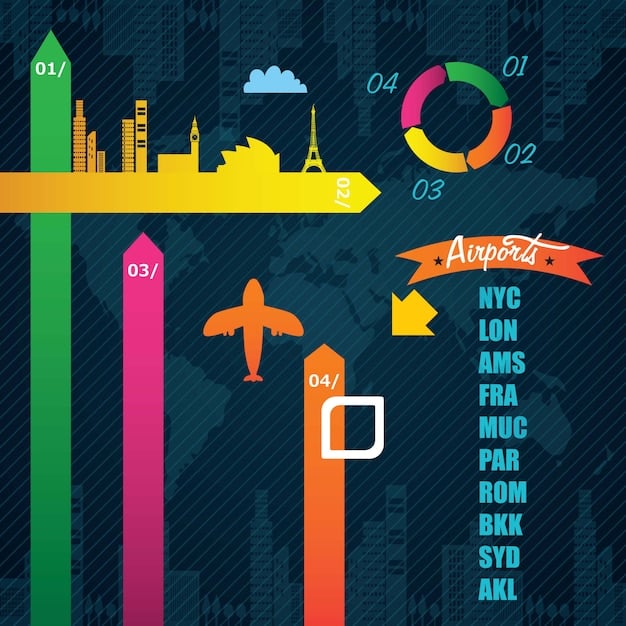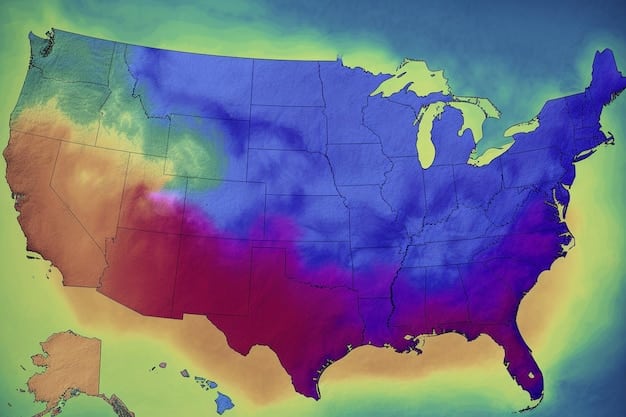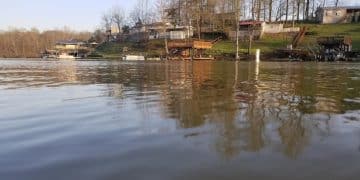Economic Costs of Climate Change: Latest US Estimates

The economic costs of climate change in the US are projected to be substantial, encompassing impacts on agriculture, coastal regions, human health, and infrastructure, with recent estimates indicating potential trillions of dollars in losses by the end of the century.
The impacts of climate change are no longer a distant threat; they are unfolding across the United States, impacting various sectors of the economy. Understanding the economic costs of climate change is crucial for policymakers, businesses, and individuals to make informed decisions about mitigation and adaptation strategies.
Understanding the Broad Economic Impacts
Climate change is expected to have widespread and significant impacts on the US economy. These impacts range from direct costs associated with extreme weather events to indirect costs stemming from disruptions to supply chains and reduced productivity.
Direct Costs of Extreme Weather
One of the most visible economic impacts of climate change is the increasing frequency and intensity of extreme weather events. Hurricanes, floods, wildfires, and droughts can cause billions of dollars in damages.
Indirect Costs and Systemic Risks
Beyond the immediate damages from extreme weather, climate change poses systemic risks to the US economy. These include disruptions to supply chains, increased insurance costs, and reduced labor productivity due to heat stress.
- Infrastructure damage can disrupt transportation networks and supply chains.
- Rising insurance costs can burden homeowners and businesses in high-risk areas.
- Reduced agricultural yields can increase food prices and decrease exports.
Analyzing these broad economic impacts provides a comprehensive view of the challenges posed by climate change and the need for proactive mitigation and adaptation measures. Ignoring these costs can lead to significant economic instability in the long term.

In conclusion, the comprehensive understanding of broad economic impacts reveals the urgent need for proactive strategies. Addressing both the visible costs of weather events and systemic risks is crucial for securing long term economic stability for the US.
Agriculture and Food Security
The agricultural sector is particularly vulnerable to the impacts of climate change. Changes in temperature, precipitation patterns, and the frequency of extreme weather events can significantly affect crop yields, livestock productivity, and overall food security.
Impact on Crop Yields
Changing climate conditions can reduce crop yields for key agricultural products such as corn, wheat, and soybeans. Higher temperatures can shorten growing seasons, while altered precipitation patterns can lead to droughts or floods.
Livestock Productivity
Livestock productivity is also affected by climate change. Heat stress can reduce milk production in dairy cows and decrease weight gain in beef cattle. Changes in forage availability can also impact livestock health and productivity.
Understanding the effects of climate change on agriculture is essential for developing adaptation strategies to ensure food security. These strategies may include investing in drought-resistant crops, improving irrigation techniques, and implementing better livestock management practices.
- Utilizing drought-resistant crops to maintain yields in water-scarce regions.
- Implementing efficient irrigation systems to conserve water resources and reduce water waste.
- Adopting better livestock management practices to mitigate heat stress and improve animal health.
Climate change poses significant challenges to agriculture, but with proactive measures, the sector can adapt and continue to provide food for the nation. Collaboration between researchers, farmers, and policymakers is crucial for developing and implementing effective adaptation strategies that ensure food security in the face of a changing climate.
Coastal Regions and Infrastructure
Coastal regions are highly susceptible to the impacts of climate change, particularly sea-level rise and increased storm surge. These impacts threaten coastal infrastructure, communities, and economies.
Sea-Level Rise
Sea-level rise is one of the most significant threats to coastal regions. As the oceans warm and glaciers melt, sea levels are rising, leading to increased flooding and erosion of coastal areas. Many communities are already experiencing the impacts from this phenomenon.
Impact on Infrastructure
Rising sea levels and increased storm surge can damage critical infrastructure in coastal areas, including roads, bridges, ports, and wastewater treatment plants. These damages can disrupt transportation, commerce, and essential services.

Protecting coastal regions and infrastructure from the impacts of climate change requires a combination of adaptation and mitigation strategies. Adaptation measures may include building seawalls, restoring coastal wetlands, and elevating infrastructure. Mitigation efforts, such as reducing greenhouse gas emissions, are also essential to slow the rate of sea-level rise and reduce the intensity of storms.
Investing in resilient infrastructure and implementing effective coastal management strategies are crucial for protecting coastal communities and economies from the economic impacts of climate change. These efforts must be prioritized to ensure the long-term sustainability of coastal regions.
Human Health Impacts
Climate change has significant implications for human health. Rising temperatures, air pollution, and changes in disease vectors can lead to a range of health problems, including heatstroke, respiratory illnesses, and infectious diseases.
Heat-Related Illnesses
Rising temperatures can increase the risk of heat-related illnesses such as heatstroke and heat exhaustion. Vulnerable populations, including the elderly, children, and outdoor workers, are particularly at risk.
Air Quality and Respiratory Illnesses
Climate change can worsen air quality by increasing the formation of ground-level ozone and particulate matter. This can exacerbate respiratory illnesses such as asthma and bronchitis.
- Implementing early warning systems and public health campaigns to protect vulnerable populations from heat waves.
- Strengthening air quality regulations and promoting cleaner energy sources to reduce air pollution.
- Investing in public health infrastructure and disease surveillance to monitor and respond to emerging health threats.
Protecting public health from the impacts of climate change requires a multi-faceted approach. This includes implementing adaptation measures to reduce exposure to health risks, as well as mitigation efforts to reduce greenhouse gas emissions and slow the pace of climate change. Collaboration between public health officials, healthcare providers, and policymakers is essential for addressing the health challenges posed by climate change.
In conclusion, addressing the human health impacts of climate change requires a collaborative and comprehensive strategy. By integrating public health considerations into climate policies and investing in prevention and preparedness, communities can better protect their populations from the health risks associated with a changing climate.
Economic Modeling and Future Projections
Economic modeling plays a crucial role in estimating the future economic costs of climate change. These models use various scenarios and assumptions to project the potential impacts on different sectors of the economy.
Integrated Assessment Models
Integrated Assessment Models (IAMs) are commonly used to assess the economic impacts of climate change. These models combine climate science with economic data to project the potential costs and benefits of different mitigation and adaptation policies.
Challenges and Uncertainties
Predicting the future economic impacts of climate change involves many challenges and uncertainties. These include the difficulty of projecting future climate scenarios, technological advancements, and policy choices.
In spite of these challenges, economic modeling provides valuable insights into the potential economic consequences of climate change. These insights can help policymakers make more informed decisions about climate policy and investment.
By understanding the potential economic costs and benefits of different actions, policymakers can develop more effective strategies to address the climate challenge and build a more resilient and sustainable economy for the future.
Mitigation and Adaptation Strategies
Addressing the economic costs of climate change requires a combination of mitigation and adaptation strategies. Mitigation involves reducing greenhouse gas emissions to slow the pace of climate change, while adaptation involves adjusting to the impacts that are already occurring or are expected to occur in the future.
Mitigation Strategies
Mitigation strategies include transitioning to renewable energy sources, improving energy efficiency, and implementing carbon pricing mechanisms. These actions can reduce greenhouse gas emissions and slow the rate of climate change.
Adaptation Strategies
Adaptation strategies include building resilient infrastructure, restoring coastal wetlands, and investing in drought-resistant crops. These actions can help communities and businesses adapt to the impacts of climate change and reduce their vulnerability.
Implementing a mix of mitigation and adaptation strategies is essential for minimizing the economic costs of climate change. Mitigation can reduce the severity of future climate impacts, while adaptation can help communities cope with the impacts that are unavoidable. By combining these approaches, the US can build a more resilient and sustainable economy for the future.
| Key Point | Brief Description |
|---|---|
| 🌊 Coastal Impacts | Sea-level rise threatens infrastructure and communities along the US coastline. |
| 🌽 Agricultural Losses | Changes in climate patterns can reduce crop yields and impact livestock productivity. |
| ⚠ Extreme Weather Costs | Increased frequency and intensity of extreme weather events drive up economic losses. |
| 🚷 Public Health Risks | Rising temperatures and air pollution pose significant threats to public health. |
Frequently Asked Questions
▼
The main sectors affected include agriculture, coastal regions, infrastructure, and public health. These sectors face various challenges from sea-level rise to extreme weather events.
▼
Sea-level rise leads to increased flooding, erosion, and damage to infrastructure, displacing communities and causing economic losses. Coastal wetlands and ecosystems are also at risk.
▼
Adaptation strategies include using drought-resistant crops, implementing efficient irrigation systems, and improving livestock management practices to mitigate heat stress and maintain productivity.
▼
Public health can be protected through early warning systems for heat waves, air quality regulations, and investment in public health infrastructure to monitor and respond to climate-related health threats.
▼
Mitigation, such as transitioning to renewable energy, can reduce long-term economic costs by slowing climate change, preventing extreme weather events, with public health gains and protecting infrastructure.
Conclusion
Addressing the economic costs of climate change is imperative for safeguarding the future prosperity and stability of the United States. By implementing proactive mitigation and adaptation strategies, investing in resilient infrastructure, and promoting public health, it is possible to mitigate the most severe economic impacts and build a more sustainable and secure nation for future generations.





